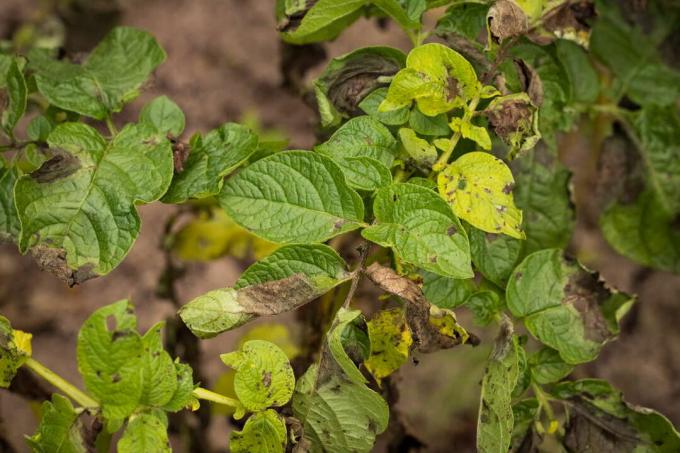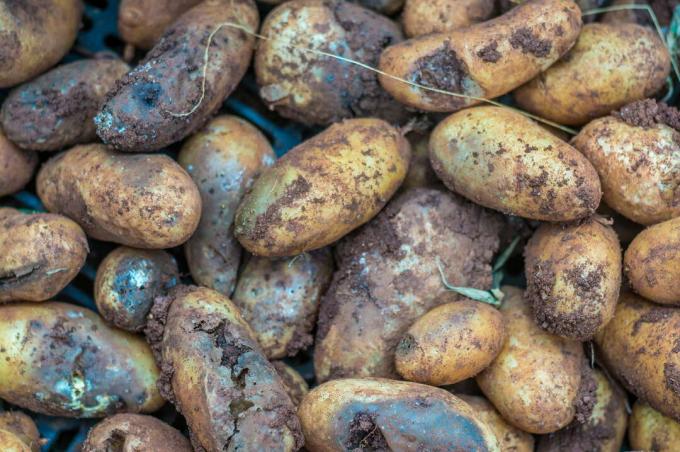Phytophthorainfestans is one of the most feared fungal pathogens. Here you can find out how you can identify and combat the infestation.

Suddenly your plants begin to wither, although nothing unusual can be seen at first glance? Strange spots form on the leaves and only rotten bulbs can be found during harvest? The cause for this could be a representative from the genus Phytophthora be.
contents
- Phytophthora: characteristics and origin
- Phytophthora: host-specific species
-
Phytophthora infestans: The late blight
- Late blight on potatoes
- Late blight on tomatoes
- Recognize Phytophthora
- Successful prevention of Phytophthora
- Fight Phytophthora efficiently
Phytophthora: Characteristics and origin
The egg mushroom Phytophthora infestans originally from Central America. Epidemics triggered in Europe as early as the 19th century. A well-known example of the devastating damage caused by this fungus is the Great Famine in Ireland between 1845 and 1852. At that time the potato was a staple food and in Ireland only two varieties of potato were grown at that time and they were very susceptible to this egg fungus. Coupled with the humid climate found in Ireland
Phytophthora infestans optimal conditions and the resulting crop failures cost the lives of around a million people. This probably proves what kind of damage this egg fungus can cause - especially in damp weather. Incidentally, the egg mushrooms are not "real" mushrooms, but a separate group of organisms that is more closely related to algae than to mushrooms, for example.
Temperatures of 15 to 23 ° C and high humidity are ideal for the egg fungus to start growing. We usually find these conditions outdoors in June. When the egg fungus that has overwintered on crop residues has ten hours of moisture continuously, the permanent spores begin to grow and germinate. The spores can be spread by the wind or find their way into your garden by the patter of rain on your plants. When the spores hit the plant, they need moisture to germinate and penetrate the plant. There they form spores and from there infect the entire plant. Potato tubers are either infected with the rot in this way or through spores that have already been in the ground.
Phytophthora is extremely adaptable and can even withstand longer dry periods without problems. It can also adapt quickly to control methods, which in no time at all creates resistance to certain pesticides that are used over and over again.
Phytophthora: Host-specific species
the Phytophthora- Mushrooms are a very large group of mushrooms. Most species specialize in certain plants or plant families. The egg fungi not only attack our vegetable crops in the garden, but also trees and bushes.
Here are a few examples:
- Phytophthora infestans: The late blight on potatoes; Late blight on tomatoes
- Phytophthora cactorum: Leather berry disease on strawberries; Branch deaths on rhododendrons; Collar rot on apple
- Phytophthora cinnamomi: Erikasterben
- Phytophthora fragariae: Red root rot on strawberries
- Phytophthora sojae: Crown rot and shoot rot on asparagus
- Phytophthora ramorum: Shoot deaths on rhododendrons;. Oak dying
- Phytophthora syringae: Lilac wilt
- Phytophthora rubi: Raspberry root death
Phytophthora infestans: The late blight
This type of egg fungus has a narrow range of host plants: it only affects the nightshade family (Solanaceae). The infestation usually causes a yield loss of 8 to 10%. In rainy years, the fungus can spread like an epidemic and destroy up to 70% of your harvest.
Late blight on potatoes
at potatoes (Solanum tuberosum), which are infected with late blight, you can see leaf stalks and stems turning brown. In addition, yellow-green to later brown spots can appear on the leaves. These spots appear soaked in water and begin at the leaf margins. When the air humidity is high, a white fungus coating also forms on the underside of the potato leaves. Eventually the leaves dry up and rot. The symptoms on the tubers are sunken, gray spots and brown discolorations on the inside of the tubers, which are not sharply demarcated from the healthy tissue. The tubers also turn brown and rot in the end.

Late blight on tomatoes
If your tomatoes (Solanum lycopersicum) with the Late blight and brown rot are infected, it can easily be that the infection started in an infected potato bed. The egg fungus usually grows on the potatoes first and the spores then often infect your tomatoes as well. The first signs are wilting leaves that turn gray-green and die off. You can also see a white fungus coating on the leaves. The stems can show dark spots, but you can often only recognize the egg fungus by the ripe tomatoes. The tomato fruits become dull and hard spots form that begin to shrink. The tomatoes then rot and are inedible.

Phytophthora recognize
If you recognize the above symptoms in your plants, you can assume that they are Phytophthora located in your garden. However, there are also possibilities of confusion:
- If your potato tubers rot, it could be causing the spot blight too. However, the putrid spots on the tubers are clearly demarcated from the healthy tissue and show rings. at Phytophthora the rotten tissue is not clearly delineated from the healthy tissue. Spray spots appear on the leaves and these can fail.
- With tomatoes you can Phytophthora confuse it with flower end rot. This rot is caused by a lack of calcium and always starts at the point where the calyx has separated from the ovary. There is only a large, brownish discolored, sunken rot on the fruit.
Phytophthora prevent successfully
The most important thing in preventing Phytophthora is the use of healthy seedlings and less susceptible varieties. Unfortunately, there are not many varieties on the market at the moment. In the case of potatoes, waxy varieties are less at risk.
As already mentioned, moisture is very important for the egg fungus. This means that plants that form dense stands, such as bush tomatoes, are more at risk. Denser crops do not dry out better - this promotes fungal infestation.
It is also important to keep a crop rotation in the garden. Should be Phytophtora have occurred in your bed, it is advisable not to use nightshades (Solanaceae) to grow more.

Since the spores spread through rain and splash water, care should be taken to water the plants carefully. If you work with irrigation (for example in your greenhouse) you should use drip irrigation instead of irrigation. Since moisture and splashing water are the biggest problems in treating the egg fungus, it is advisable to have one To put up a small canopy for your tomatoes or the plants in a rain-protected, sunny place to set up. A terrace or the wall of a building is ideal for growing the tomatoes in a protected manner.
More tips to help prevent Phytophthora:
- Don't overdo it with the fertilizer:
Do not use too much nitrogen fertilizer, over-fertilization can encourage the egg fungus to grow. A long-term fertilizer with a high concentration of potassium like ours Plantura organic tomato fertilizer is a very good choice for prevention. - Avoid waterlogging:
Drain your garden or work in some gravel or sand to loosen up the soil. This promotes the drainage of water and improves the water and air balance in your garden. - Caution when harvesting:
Be careful not to damage anything during harvest and also check your stored tubers for infestation. - Dispose of harvest waste:
Since the egg fungus overwinters in infected parts of plants, such crop waste and plant parts should be removed to be on the safe side in order to prevent an infestation in the next year.
Phytophthora fight efficiently
Has it now happened, despite all caution, that Phytophtora occurs to you, it is important to remove the infected, diseased plants. Don't dispose of infested plants in your compost - these diseased plants belong in the household waste, where they can no longer infect other plants. Since this egg fungus overwinters on the crop waste, these parts should not end up on the compost or be left in the garden.

Also thoroughly clean and disinfect all equipment that has come into contact with the diseased plants. If the infestation is very strong, you can also replace the contaminated soil with fresh one. Be careful not to spread the infection further.
Fungicides are another way of combating this. Most of these pesticides, however, are preventative and should be used in damp weather.
When using pesticides, careful handling is the most important thing. Always read the instructions for use before use and follow the instructions.
Another fungus that causes problems for many plants is the egg fungus Pythium. We have information for you on how to identify and combat Pythium.



